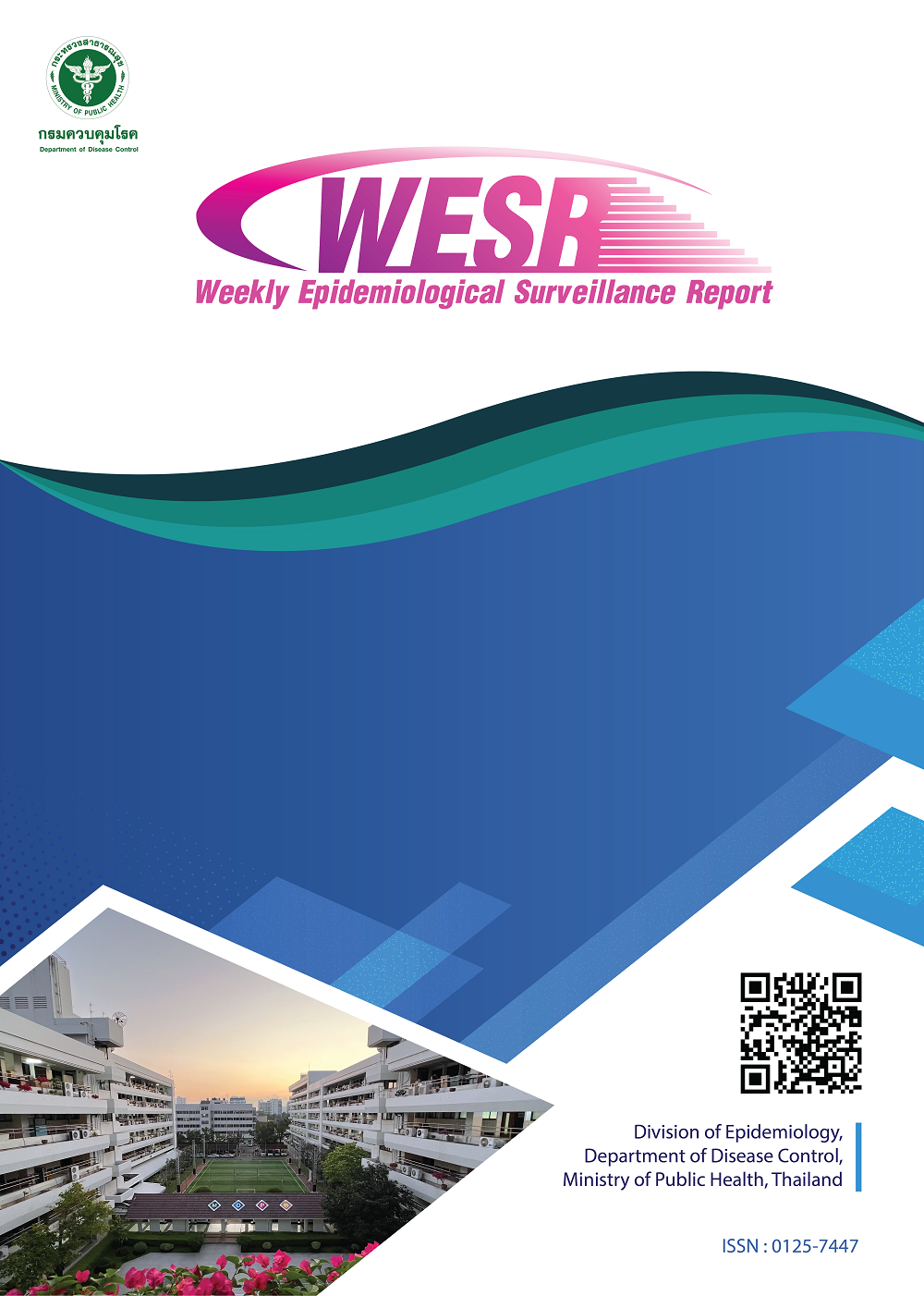Norovirus outbreak in five schools of Nakorn Ratchasima Province, Thailand, 2016
Keywords:
Norovirus, Acute gastroenteritis, Nakorn Ratchasima provinceAbstract
Backgrounds: On 24th November 2016, Bureau of Epidemiology (BoE) received notification of 216 food poisoning cases in 5 schools in Nakorn Ratchasima province. BoE, Office of Disease prevention and control 9th region and Nakorn Ratchasima Provincial Health Office jointly conducted an investigation to identify the causative organism of the outbreak, to find the implicated food and water of the outbreak, to describe the contamination method and to identify the source of the outbreak.
Methods: Active case finding was done to find further cases in school. Rectal swab specimens were collected in acute gastroenteritis cases that still had symptoms. Retrospective cohort study was done in school with highest attack rate. Unmatched case-control study was performed in school that received food and water ingredients from more than one source. Environmental survey and specimens’ collection were done in schools and suspected potential sources of contamination.
Results: There were 518 acute gastroenteritis cases in school A, B, C, D and E with attack rates of 8.69%. Most cases consumed ice with water and presented with abdominal pain, nausea and vomiting. Laboratory results revealed positive Norovirus from polymerase chain reaction (PCR) in 6 of 17 specimens (35.29%). Retrospective cohort study was done in school D and revealed association between consuming ice with drinking water and occurrence of the outbreak, adjusted OR was 3.59 (95% CI 1.58–8.14). Ice factory A was suspected because 4 schools received ice from this factory. Unmatched case-control study was done in school A and revealed association between consuming ice from ice factory A and occurrence of the outbreak, adjusted OR was 3.35 (95% CI 1.58–7.10). Ice production pathway of ice factory A was a closed system. Laboratory result from ice specimen of ice factory A revealed positive for Vibrio cholerae non O1/non O139/non 141 without cholera toxin.
Conclusions: This was an acute gastroenteritis outbreak in multiple schools caused by Norovirus. Ice consumed with other drinks was associated with occurrence of the outbreak which presented mainly as upper gastrointestinal symptoms. Ice factory A was suspected as the source of the outbreak, however the method of contamination was unknown.
References
Guandalini S. Treatment of acute diarrhea in the new millennium. J Pediatr Gastroenterol Nutr 2000; 30(5): 486-9.
Kapikian AZ, Wyatt RG, Dolin R, Thornhill TS, Kalica AR, Chanock RM. Visualization by immune electron microscopy of a 27-nm particle associated with acute infectious nonbacterial gastroenteritis. J Virol 1972; 10: 1075-81.
Centers for Disease Control and Prevention. Updated Norovirus Outbreak Management and Disease Prevention Guidelines. MMWR 2011; 60 (No. RR-03): 1-15.
ปิยะณัฐ บุญประดิษฐ์. การสอบสวนโรคอาหารเป็นพิษจากไวรัสโนโรในโรงเรียนประถมศึกษาแห่งหนึ่งตำบลหน้าเมือง อำเภอเมือง จังหวัดราชบุรี วันที่ 17–27 มิถุนายน 2557. รายงานการเฝ้าระวังทางระบาดวิทยาประจำสัปดาห์ 2558; 46: S52-9.
สำนักระบาดวิทยา กรมควบคุมโรค กระทรวงสาธารณสุข. โปรแกรมตรวจสอบข่าวทางระบาดวิทยา (ออนไลน์). เข้าถึงได้จาก www.boeeoc.moph.go.th/eventbase/
วุฒิไกร ศักดิ์สุรกานต์, วิชัย ธนาโสภณ, ราเมศร์ อำไพพิศ, กิตติ บุญรัตนเนตร, เบ็ญจวรรณ วิจารณปัญญา, ขจรพงศ์ นครเมือง, พิมลพร คดีธรรม. การสอบสวนการระบาดของโรคติดเชื้อไวรัสโนโร อำเภอสัตหีบ จังหวัดชลบุรี เดือนสิงหาคม-กันยายน 2557. รายงานการเฝ้าระวังทางระบาดวิทยาประจำสัปดาห์ 2558; 46: 177-84.
กรรณิการ์ เครื่องชนะ. การตรวจวิเคราะห์คุณภาพทางจุลชีววิทยาของน้ำแข็งจากร้านจำหน่ายเครื่องดื่มรอบมหาวิทยาลัยนเรศวร จังหวัดพิษณุโลก. [วิทยานิพนธ์ปริญญาวิทยาศาสตรบัณฑิต]. พิษณุโลก: มหาวิทยาลัยนเรศวร; 2558.
Downloads
Published
How to Cite
Issue
Section
License
Copyright (c) 2019 Weekly Epidemiological Surveillance Report

This work is licensed under a Creative Commons Attribution-NonCommercial-NoDerivatives 4.0 International License.
1. เนื้อหาและข้อมูลในบทความที่ลงพิมพ์กับ WESR ถือเป็นข้อคิดเห็น และความรับผิดชอบของผู้เขียนบทความโดยตรงซึ่งกองบรรณาธิการวารสารไม่จำเป็นต้องเห็นด้วย หรือร่วมรับผิดชอบใด ๆ
2. บทความ ข้อมูล เนื้อหา รูปภาพ ฯลฯ ที่ได้รับการตีพิมพ์ใน WESR ถือเป็นลิขสิทธิ์ของวารสารวิชาการ หากบุคคลหรือหน่วยงานใดต้องการนำทั้งหมดหรือส่วนหนึ่ง ส่วนใดไปเผยแพร่ กรุณาอ้างอิงบทความนั้น ๆ




